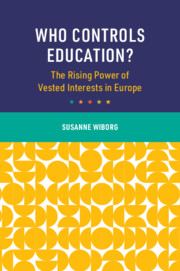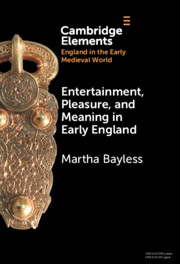339 results
2 - Getting Entrenched
-
- Book:
- Who Controls Education?
- Published online:
- 26 March 2025
- Print publication:
- 03 April 2025, pp 36-60
-
- Chapter
- Export citation

Who Controls Education?
- The Rising Power of Vested Interests in Europe
-
- Published online:
- 26 March 2025
- Print publication:
- 03 April 2025
6 - Putting the Spoke(s) in: Curial Centrality and Local Agency in the Pre-Reformation Church
- from Part II - The Roman Curia
-
-
- Book:
- The Cambridge History of the Papacy
- Published online:
- 28 February 2025
- Print publication:
- 20 March 2025, pp 157-181
-
- Chapter
- Export citation
3 - The Rise and Fall of the United Kingdom’s Forgotten Utility Model
- from Part I - Utility Model Laws and Practices around the World
-
-
- Book:
- Sub-patent Innovation Rights
- Published online:
- 06 February 2025
- Print publication:
- 13 February 2025, pp 31-85
-
- Chapter
-
- You have access
- Open access
- HTML
- Export citation
Chapter One - The Appeal of the Subversive
- from Part I
-
- Book:
- Reforming Art in Renaissance Venice
- Published online:
- 24 January 2025
- Print publication:
- 13 February 2025, pp 39-78
-
- Chapter
- Export citation
The mental health impact of repeated COVID-19 enforced lockdowns in England: evidence from the UK Household Longitudinal Study
-
- Journal:
- BJPsych Open / Volume 11 / Issue 1 / January 2025
- Published online by Cambridge University Press:
- 13 January 2025, e16
-
- Article
-
- You have access
- Open access
- HTML
- Export citation
‘Thanks to technology’: discourse, care and technology in England
-
- Journal:
- Ageing & Society , First View
- Published online by Cambridge University Press:
- 07 January 2025, pp. 1-27
-
- Article
- Export citation

Ladies-in-Waiting in Medieval England
-
- Published online:
- 02 January 2025
- Print publication:
- 09 January 2025

Entertainment, Pleasure, and Meaning in Early England
-
- Published online:
- 04 December 2024
- Print publication:
- 02 January 2025
-
- Element
- Export citation
10 - Britain
- from Part II - Country Case Studies
-
- Book:
- Industrial Policy for the United States
- Published online:
- 08 November 2024
- Print publication:
- 21 November 2024, pp 202-226
-
- Chapter
- Export citation
4 - Grammatical Variation in England
- from Part I - English
-
-
- Book:
- Language in Britain and Ireland
- Published online:
- 17 October 2024
- Print publication:
- 31 October 2024, pp 98-127
-
- Chapter
- Export citation
Where is everybody? The unburied dead in late Roman and early medieval England
- Part of
-
- Article
-
- You have access
- Open access
- HTML
- Export citation
Material and Digital Archives: The Case of Wills
-
- Journal:
- Transactions of the Royal Historical Society / Volume 2 / December 2024
- Published online by Cambridge University Press:
- 26 September 2024, pp. 441-470
- Print publication:
- December 2024
-
- Article
-
- You have access
- Open access
- HTML
- Export citation
Chapter 2 - The long road to the SWPA
-
- Book:
- Assault Brigade
- Published online:
- 25 October 2024
- Print publication:
- 29 August 2024, pp 28-47
-
- Chapter
- Export citation
The Mortar Wreck: a mid-thirteenth-century ship, wrecked off Studland Bay, Dorset, carrying a cargo of Purbeck stone
- Part of
-
- Article
-
- You have access
- Open access
- HTML
- Export citation
16 - Sexual Pleasures and Perils in Nineteenth-Century London
-
-
- Book:
- The Cambridge World History of Sexualities
- Published online:
- 26 April 2024
- Print publication:
- 16 May 2024, pp 329-352
-
- Chapter
- Export citation
Bad Religion and Bad Business: The History of the Canadian Witchcraft Provision
-
- Journal:
- Canadian Journal of Law & Society / La Revue Canadienne Droit et Société / Volume 39 / Issue 1 / April 2024
- Published online by Cambridge University Press:
- 02 May 2024, pp. 154-173
-
- Article
-
- You have access
- Open access
- HTML
- Export citation
THREE LATE FIFTEENTH- EARLY SIXTEENTH-CENTURY CHAPEL FURNISHINGS BELONGING TO THE EDGCUMBE FAMILY IN CORNWALL
-
- Journal:
- The Antiquaries Journal / Volume 104 / October 2024
- Published online by Cambridge University Press:
- 25 April 2024, pp. 145-168
- Print publication:
- October 2024
-
- Article
-
- You have access
- HTML
- Export citation
Chapter 4 - England and Ireland
- from Part I - Places
-
-
- Book:
- Robert Lowell In Context
- Published online:
- 28 March 2024
- Print publication:
- 04 April 2024, pp 41-52
-
- Chapter
- Export citation
10 - British Reformations Compared
-
-
- Book:
- Reformations Compared
- Published online:
- 14 March 2024
- Print publication:
- 21 March 2024, pp 214-241
-
- Chapter
- Export citation


